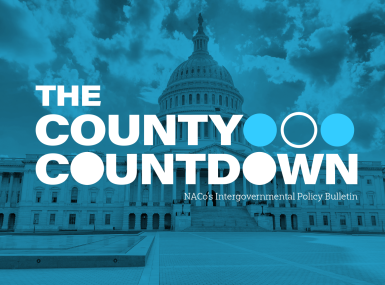Companion legislation introduced to reauthorize and reform the National Flood Insurance Program

Key Takeaways
In late July, bipartisan bills in both the U.S. House and the U.S. Senate were introduced to reauthorize and reform the National Flood Insurance Program (NFIP). The bills, S. 2187 (sponsored by Sen. Robert Menendez (D-N.J.) and H.R. 3872 (sponsored by Rep. Frank Pallone, Jr. (D-N.J.), would reauthorize the program for five-years and make key reforms to enhance and modernize NFIP.
NFIP was created under the National Flood Insurance Act of 1968 to provide insurance coverage to property owners for damages and losses due to catastrophic flooding. The new proposed legislation would represent the first long-term reauthorization of the NFIP since the Biggert-Waters Flood Insurance Reform Act of 2012 (P.L. 112-141), which expired in 2017. The program has operated under a series of 12 short-term extensions since, with the most recent extending the program until September 30, 2019. Counties also have a significant stake in the NFIP program, as we use funding administered through the program to develop mitigation plans to better prepare for future flooding.
The new bills include a wide variety of reforms, many of which are of interest to counties:
Affordability and Access to Coverage
The new proposals would reform the affordability and accessibility of the program for policy holders, impacting residents in counties across the country. Some specific changes in the bill include:
- Creating a five-year pilot program to provide means-tested assistance for low-income policy holders
- Capping annual rate increases to 9 percent. Currently, premiums can increase by up to 25 percent each year for the lifecycle of the policy.
- Authorizing monthly premium payments to ensure low-income policy holders can afford flood insurance.
- Requiring the Federal Emergency Management Agency (FEMA) to perform a study on its ability to offer business interruption coverage, which would cover loss of income and assets a business may experience as a result of a flood.
Mitigation
The legislation would seek to enhance the mitigation techniques made available to policy holders by reforming the NFIP to include:
- Setting aside 10% of disaster assistance allocated to FEMA’s Disaster Relief Fund (DRF) for buyouts, elevation and other mitigation for the highest risk properties covered under NFIP.
- Requiring FEMA, through NFIP, to develop strategies to help urban communities mitigate flood risk in places where elevation is not feasible and offer premium credits for taking advantage of these strategies.
- Authorizing FEMA to create a low-interest mitigation loan.
- Establishing a revolving loan fund for the purpose of mitigation with a priority given to high-flood risk states as defined by FEMA. The initial funds are supplied by both FEMA and the state, and then loaned out at low interest rates to help communities, schools, families and businesses mitigate flood risk.
- Pushing FEMA to give priority to flood mitigation activities that provide benefits on a floodplain-wide or community-wide basis to have impact on a community or specific part of a community.
Mapping
This legislation would reform the NFIP by instituting proper mapping techniques to help mitigate against future disasters, including:
- Authorizing nearly $400 million per year for improvements to the National Flood Mapping Program to increase accuracy of flood mapping.
- Providing communities with the ability to appeal flood maps.
Program Administration/Consumer Protection
The new proposals would also make changes to the administration of the NFIP, which has long served as a pain point for many policy holders. Reforms would include:
- Temporarily freezing interest payments on the NFIP debt to restore the program to solvency and reduce future borrowing. Providing forbearance on these interest payments will free up approximately $400 million per year to invest in more cost-effective mitigation efforts.
- Requiring FEMA to process all flood claims within 60 days of the policy holder filing with an extension of 30 days under extraordinary circumstances.
- Requiring the disclosure of flood risk and prior flood damage to lessors and homebuyers prior to transfer.
NACo will continue engaging with both House and Senate lawmakers to include additional reform provisions that address program improvements important to counties. Counties support a long-term reauthorization of the NFIP and encourage Congress to achieve this goal prior to the September 30 expiration deadline.

UPDATE: On September 27, President Trump signed a continuing resolution (CR) (H.R. 4378) to fund the government through November 21. Included as part of this package was an extension of the National Flood Insurance Program, which was set to expire on September 30. The extension will provide lawmakers with additional time to reach a potential agreement on a long-term reauthorization of the program.
Attachments
Related News

President Trump signs Laken Riley Act into law
On January 29, President Trump signed the bipartisan Laken Riley Act into law, requiring the U.S. Department of Homeland Security to detain any undocumented immigrant who has been arrested for violent or property-related crimes and giving states new authority to sue the federal government over certain immigration-related decisions.

County Countdown – January 28, 2025
Every other week, NACo's County Countdown reviews top federal policy advocacy items with an eye towards counties and the intergovernmental partnership.

Congress reintroduces 9-1-1 SAVES Act
On January 16, the 9-1-1 Supporting Accurate Views of Emergency Services (SAVES) Act was reintroduced in the U.S. House of Representatives. This legislation aims to officially reclassify 9-1-1 dispatchers as first responders, granting these professionals the recognition they deserve for their vital contributions to public safety.
